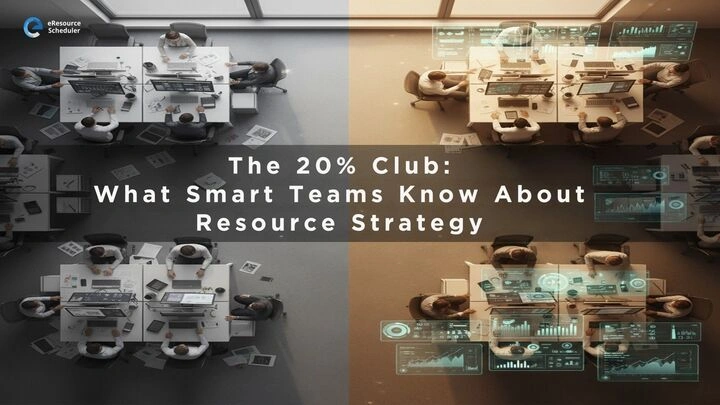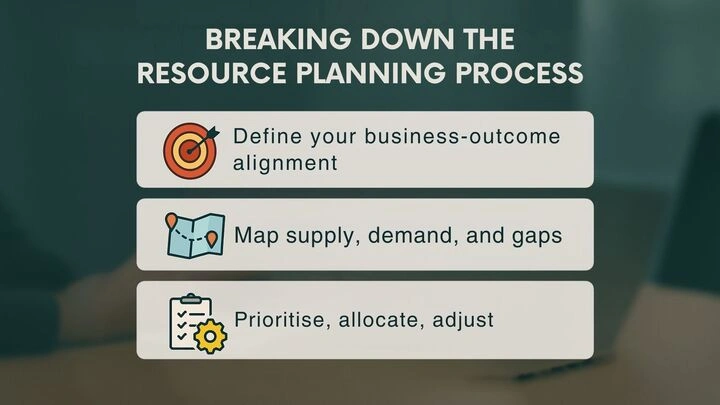
Only a fraction of teams truly get resource strategy right. They’re the 20% that plan ahead, balance priorities, and link every hour of work to business outcomes. The rest? They are busy firefighting, reacting, reallocating, and constantly catching up.
A strong resource strategy isn’t just about scheduling people. It’s about aligning capacity with demand, effort with goals, and skills with impact. Smart teams back their plans with tools like resource allocation software, treating strategy as a living system—one that evolves with projects, clients, and priorities.
A resource strategy is how organizations turn plans into performance. It defines who does what, when, and why without stretching capacity thin or stalling delivery.
When teams skip strategy, chaos creeps in. People get overbooked, deadlines slip, and burnout follows. It’s not just an operational issue, it’s a business risk. Without a clear resource management strategy, decisions become reactive instead of proactive.
Great teams don’t wait for bottlenecks. They anticipate them. By building visibility into capacity and demand, they know what’s coming before it hits and plan accordingly.
Most project failures aren’t due to lack of talent, they stem from poor alignment. A clear business outcomes alignment ensures that every resource decision moves the organization closer to its goals, not sideways.

A robust resource management strategy has a few non-negotiables. Each one keeps the plan realistic, flexible, and measurable.
The best strategies start with purpose. Before any allocation, define your priorities. What’s the outcome you’re chasing? Growth? Efficiency? Client satisfaction?
Every resource plan should ladder up to that focus, otherwise, you’re just distributing work, not value.
You can’t manage what you can’t see. Visibility into team availability, workload, and skill sets forms the core of any good resource planning process.
Use dashboards, reports, and real-time views that highlight who’s busy, who’s available, and what projects are next. Tools like resource scheduling software make this effortless.
Rigid plans break fast. Smart teams build flexibility into their resource planning software workflows. That way, if priorities shift, resources can be reallocated quickly without disruption.
The 20% Club reviews its resource strategy regularly. After each quarter or project cycle, they ask:
Those insights feed the next cycle, keeping the resource planning process sharp and adaptive.
Start by asking: What business outcomes are we driving? Your resource strategy must support those. When you link resource allocation to strategic goals, you stop allocating minutes and start allocating impact. That link is critical for a strong resource management strategy.
Next: inventory what you have (skills, capacity, tools) vs what you’ll need (projects, deadlines, market shifts). This is the heart of your resource planning process. The clearer your view, the fewer nasty surprises.
Not all work is equal. Use your strategy to decide what gets resources first. Then allocate using appropriate tools (yes: resource scheduling software or resource planning software). Finally, keep reviewing and adjusting because the real world isn’t static.
When one or two people carry most of the weight, your resource strategy is brittle. Spread knowledge, build bench strength, and allocate smarter.
Plans are great but if they assume everything stays the same, you’re sunk. Build flexibility into your resource management strategy from the start.
Buying resource scheduling software without a clear resource strategy is like buying a sports car and never driving it. Tools support strategy, they don’t replace it.
If your only metric is “are people busy”, you’ll drive burnout and miss alignment. Focus instead on “are the right people doing the right things at the right time” as part of an effective resource strategy.
If you allocate, deliver, and move on without reviewing what happened, you’ll repeat mistakes. Make your resource planning process iterative.
Smart teams don’t rely on spreadsheets alone. They use resource scheduling software and resource planning software (or full-blown resource allocation software) to map, monitor, and adjust their plan. This reduces guesswork and boosts accuracy.
For them, resource strategy isn’t only a document but an actual conversation. It threads through planning meetings, performance reviews, and decision-making. It becomes how people operate rather than something tucked away.
They ask: “If we allocate resources here, what business outcome does it move?” Rather than “who’s free next week?” This line of thinking keeps the resource planning process tight and meaningful.
Instead of squeezing every percentage of capacity, they build intentional slack and contingency. Good resource strategies balance utilisation and availability for unexpected demands.
Post-project reviews happen. They look at what worked, what didn’t, and what spilled over, and their resource planning process evolves. That’s how a team stays in the top 20%.
The difference between busy teams and brilliant ones lies in how intentionally they plan. The 20% Club doesn’t just juggle schedules, they know that a great resource strategy isn’t a spreadsheet; it’s a system that keeps people, projects, and profits in sync.
If your team’s ready to move beyond firefighting and start planning with foresight, it’s time to see what smarter resource management looks like in action.
Book a quick demo of eResource Scheduler (eRS) and see how effortless it can be to plan, allocate, and deliver with clarity.
Because strategy shouldn’t slow you down, it should set the pace.
1. What exactly is a “resource strategy”?
A resource strategy is a plan that outlines how you will allocate and manage your resources (people, tools, time) in a way that supports your overall business goals.
2. How does a resource strategy differ from a resource management strategy?
They overlap, but a resource strategy is more about the high-level “what and why”: what resources, why certain projects. A resource management strategy is more about the “how” of day-to-day utilization.
3. Why is aligning resource strategy with business outcomes important?
Because if resources are busy but working on the wrong things, you’re wasting effort. Linking to business outcomes makes your resource strategy meaningful.
4. Can resource planning software really improve my resource strategy?
Yes. When paired with a proper strategy, the tool becomes your execution platform, supporting your resource planning process, giving visibility and agility.
5. How often should a resource strategy be reviewed?
Ideally quarterly, though the best teams revisit parts of it monthly or as project pipelines shift, so it stays current and connected to real-world changes.
Plan Smarter. Schedule Faster.
Join thousands already using eResource Scheduler to align teams, time, and tasks seamlessly.